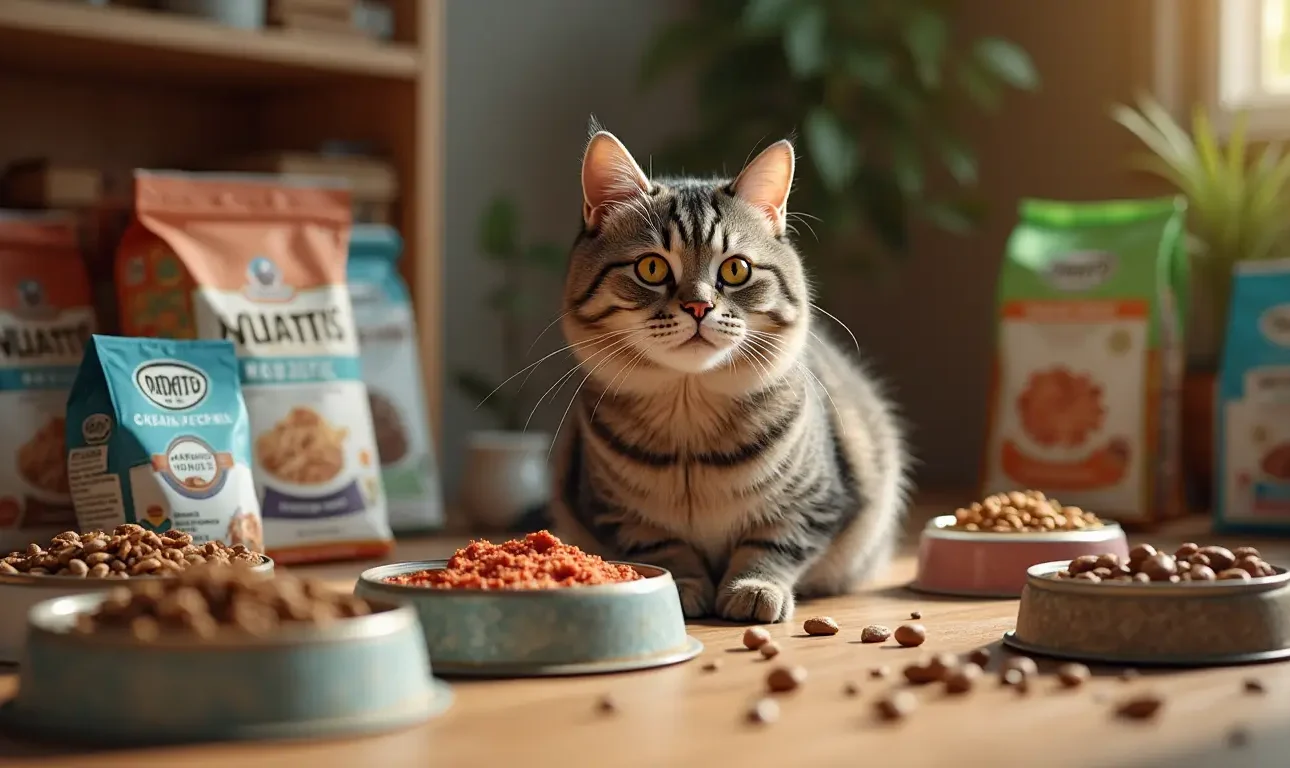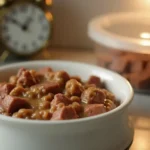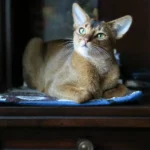As cat owners, we want the best for our feline companions, and that starts with what we feed them. Just like humans, cats require a well-balanced diet to stay healthy, active, and happy. A nutritious diet can help maintain their weight, boost their immune system, improve their coat and skin, and even support a longer lifespan. The right cat food provides essential nutrients like protein, vitamins, and minerals that are crucial for their overall well-being.
In this post, we’ll guide you through the top 10 best foods for cats in 2025. Whether you’re looking for options for kittens, adult cats, or senior felines, this guide will help you choose the best food for your cat’s needs. From high-protein meals to grain-free options, we’ll cover the top choices that ensure your feline friend gets the nutrition they deserve in the year ahead.
Table of Contents
Why Choosing the Right Food is Crucial for Your Cat’s Health
A balanced diet is essential to your cat’s overall health, as the right food supports every aspect of their well-being. From maintaining healthy organs to promoting a shiny coat, the food you choose plays a pivotal role in your cat’s quality of life. Let’s break down why choosing the right food is so important.
Understanding Cat Nutrition: The Importance of Protein, Fat, and Carbohydrates
Cats are obligate carnivores, which means that protein is the most important nutrient in their diet. Protein provides the essential amino acids that cats need for energy, muscle growth, and tissue repair. The best cat foods feature high-quality animal-based protein sources like chicken, turkey, or fish. Along with protein, healthy fats are critical in your cat’s diet to support their skin, coat, and brain function. Fats also help your cat absorb fat-soluble vitamins like A, D, E, and K.
While carbohydrates are not a major part of a cat’s diet, small amounts are typically found in fruits and vegetables and can serve as a good source of fiber, helping to support digestion. However, it’s important that the carbohydrates used in cat food are digestible and not fillers like corn or wheat, which provide little nutritional value.
Age-Specific Needs: How Food Needs Differ for Kittens, Adult Cats, and Senior Cats
The nutritional requirements of cats change as they move through different life stages. Kittens need higher levels of protein and calories to support their rapid growth and development. Foods designed specifically for kittens offer increased levels of protein and fat to meet these needs.
Adult cats require a balanced, moderate amount of protein, fat, and fiber to maintain their energy levels and muscle mass. It’s important to feed adult cats food that helps maintain a healthy weight and supports overall vitality.
Senior cats, on the other hand, may have special needs due to aging health concerns. As cats age, their metabolism slows down, and they may require fewer calories but more easily digestible protein. Additionally, senior cats may need foods that support joint health, urinary tract health, and kidney function.
Health Considerations: Special Diets for Cats with Sensitivities, Allergies, or Specific Health Conditions
Some cats have unique dietary needs due to health issues or sensitivities. For example, cats with food allergies may benefit from limited-ingredient diets or hypoallergenic foods that avoid common allergens like grains, poultry, or beef. Cats with digestive issues or sensitive stomachs often do better with easily digestible proteins and high-quality fats.
Cats with obesity may require a weight management formula that’s lower in fat and calories, while still providing adequate nutrition. Special foods can also support cats with conditions such as urinary tract infections, kidney disease, or diabetes, ensuring they get the nutrients they need without exacerbating their health issues.
Choosing the right food based on your cat’s specific needs is vital for ensuring a healthy, happy, and long life. Understanding their nutritional requirements and considering their age, health condition, and sensitivities will help you make the best choice for your feline friend.
Top 5 Best Wet Foods for Cats in 2025
Wet food is often a popular choice for cat owners due to its higher moisture content, which is beneficial for your cat’s hydration and overall health. If you’re looking for top-notch wet food options for your cat, here are five of the best choices in 2025 that are sure to provide your feline friend with balanced nutrition and great taste.
1. Hill’s Science Diet Wet Cat Food
Hill’s Science Diet is a well-known and trusted brand among veterinarians. Their wet cat food is carefully crafted to support digestive health and overall well-being. With high-quality protein sources like chicken, tuna, and salmon, this food helps maintain lean muscle mass and provides essential nutrients. It’s available in a wide variety of flavors, making it easy to find something your cat will enjoy. Hill’s Science Diet also offers options specifically for kittens, adult cats, and senior cats, so you can find the right formula for your pet’s life stage.
2. Blue Buffalo Homestyle Recipe
Blue Buffalo is known for using natural, wholesome ingredients, and their Homestyle Recipe line is no exception. Featuring real meat as the first ingredient, Blue Buffalo’s wet food is free from artificial preservatives, colors, and flavors, as well as by-products and fillers. This makes it a highly nutritious choice that provides your cat with the protein it needs while avoiding harmful additives. The Homestyle Recipe comes in various flavors such as chicken, turkey, and beef, so you can choose the one your cat prefers.
3. Wellness CORE Grain-Free Wet Food
For cats with grain sensitivities, Wellness CORE Grain-Free Wet Food is an excellent choice. With real meat as the first ingredient, this high-protein, grain-free formula is designed to support lean body mass and muscle tone. It’s also free of fillers like corn and soy, making it ideal for cats with food sensitivities or allergies. Wellness CORE offers a variety of delicious options, including chicken, turkey, and salmon, which are packed with essential nutrients that promote overall health and vitality.
4. Merrick Grain-Free Wet Cat Food
Merrick’s Grain-Free Wet Cat Food is another great option for cats with dietary sensitivities. With real fish and poultry as the first ingredients, Merrick ensures that your cat gets the high-quality protein it needs for a strong, healthy body. This wet food is free from grains, gluten, and fillers, making it a great choice for cats with food allergies or sensitive stomachs. Merrick offers a variety of flavors such as turkey, chicken, and salmon, and each formula is crafted to support your cat’s overall health.
5. Iams ProActive Health Wet Cat Food
For a more affordable yet balanced option, Iams ProActive Health Wet Cat Food is a great choice. Known for its nutritional value and great taste, Iams ProActive Health is made with high-quality proteins like chicken and salmon, offering the necessary amino acids for muscle growth and energy. It’s specially formulated to provide balanced nutrition for adult cats, including a blend of fiber and prebiotics to support digestive health. This food provides a cost-effective way to feed your cat without compromising on quality.
Best Dry Cat Foods for 2025: High-Quality Options
Dry cat food offers a convenient and cost-effective way to feed your cat, while also helping to keep their teeth clean through the chewing process. When choosing the best dry food, it’s important to focus on high-quality ingredients, optimal nutrition, and special formulations for your cat’s needs. Here are five of the best dry cat foods for 2025 that provide top-notch nutrition and support your feline friend’s overall health.
1. Royal Canin Feline Health Nutrition
Royal Canin is well-known for creating tailored formulas to meet the unique needs of specific cat breeds, ages, and health conditions. Whether you have a kitten, an adult, or a senior cat, Royal Canin offers a dry food option that supports your pet’s specific requirements. Their formulas are designed to promote optimal digestive health, healthy skin, and coat, as well as support urinary tract health in cats prone to issues. With specialized blends for different breeds and conditions, such as the Persian or Maine Coon, Royal Canin ensures that your cat’s nutritional needs are met, regardless of their stage of life.
2. Orijen High-Protein Dry Cat Food
Orijen offers a biologically appropriate diet for cats, which means it’s designed to closely match what a cat would eat in the wild. Made with fresh, regional ingredients, this high-protein dry cat food features chicken, turkey, and fish as the primary sources of protein. With a protein content that’s higher than many other brands, Orijen supports healthy muscle mass, energy, and a lean body composition. It also contains no grains or fillers, making it an excellent choice for cats who may have sensitivities or allergies. This food is a premium option that prioritizes quality ingredients and balanced nutrition.
3. Natural Balance L.I.D. Limited Ingredient Diets
For cats with food sensitivities or allergies, Natural Balance L.I.D. Limited Ingredient Diets is an excellent option. This dry food is designed with a single animal protein source, such as duck or salmon, and a limited number of ingredients to reduce the risk of food sensitivities. It’s also free from grains, soy, and artificial additives, making it gentle on your cat’s digestive system. Natural Balance’s limited ingredient diet ensures that your cat gets the essential nutrients they need while avoiding common allergens that may cause digestive upset or skin issues.
4. Nutro Wholesome Essentials
Nutro Wholesome Essentials is a highly nutritious dry food option for both indoor and outdoor cats. With chicken as the primary ingredient, it provides a high-quality protein source that supports healthy muscle development and overall vitality. This food also includes a blend of whole grains, including brown rice and oatmeal, which provide fiber to aid digestion. Additionally, Nutro Wholesome Essentials contains essential fatty acids to promote healthy skin and a shiny coat. This well-rounded food is suitable for cats of all life stages and is an excellent choice for those seeking a reliable, balanced diet.
5. Pedigree Dry Cat Food
If you’re looking for an affordable yet nutritionally balanced dry food, Pedigree Dry Cat Food offers great value without compromising quality. With real chicken as the main ingredient, Pedigree provides a source of protein to support your cat’s muscles and overall health. It’s also formulated with a blend of vitamins and minerals to support your cat’s immune system, skin health, and digestion. Pedigree is designed to be a budget-friendly option that still delivers the essential nutrients your cat needs to thrive. While not as premium as some of the other brands on the list, it’s a solid choice for those on a budget.
Grain-Free & Hypoallergenic Cat Food Choices for Sensitive Cats
If your cat has a sensitive stomach, food allergies, or sensitivities, choosing the right diet is essential for their comfort and health. Grain-free and hypoallergenic foods are designed to minimize digestive issues and allergic reactions, offering a more natural and gentle approach to feeding your feline friend. Here are some of the best grain-free and hypoallergenic cat food options for 2025 that are ideal for cats with sensitive digestive systems or allergies.
1. Nature’s Logic
Nature’s Logic offers a natural, grain-free option that is made with whole foods and free from artificial additives, preservatives, or by-products. This food is an excellent choice for cats with food sensitivities, as it uses high-quality animal proteins, such as chicken or lamb, as its primary ingredient. The formulas are designed to be highly digestible, supporting optimal digestive health while providing all the essential nutrients your cat needs. Nature’s Logic is also rich in omega fatty acids, which promote healthy skin and a shiny coat, making it a great choice for cats with skin allergies or sensitivities.
2. Instinct Raw Boost Mixers
For cats with sensitive stomachs or those who benefit from a raw food diet, Instinct Raw Boost Mixers provide a unique option. This food features a mix of high-quality kibble and freeze-dried raw pieces, which offer a protein-packed, nutrient-rich diet that closely mimics what a cat would eat in the wild. The raw pieces are made with real meat like chicken or turkey, providing a natural source of amino acids, vitamins, and minerals. This high-protein formula supports lean muscle mass and digestive health, while being gentle enough for cats with sensitivities. Instinct Raw Boost Mixers is free from grains, gluten, and soy, making it an ideal choice for cats with food allergies.
3. Taste of the Wild High-Protein Dry Cat Food
Taste of the Wild High-Protein Dry Cat Food is a grain-free formula that offers a variety of protein sources, including roasted venison, roasted duck, and smoked salmon. These novel proteins are excellent for cats with food allergies or sensitivities to common ingredients like chicken or beef. The food is designed to mimic a wild, natural diet, providing your cat with the high-quality protein they need for energy and muscle maintenance. In addition to being grain-free, this food also contains probiotics to support digestion and antioxidants to promote immune health. It’s a great option for both cats with sensitivities and those who simply thrive on a high-protein diet.
4. Royal Canin Veterinary Diet Hypoallergenic
Royal Canin’s Veterinary Diet Hypoallergenic formula is specifically designed for cats with food allergies or sensitivities. This diet features hydrolyzed proteins, which are broken down into smaller particles that are less likely to trigger an allergic reaction. It’s formulated to help reduce the risk of food-induced allergies while providing balanced nutrition for overall health. The hypoallergenic formula also includes a mix of fiber to promote digestive health and Omega-3 fatty acids for a healthy coat and skin. Royal Canin’s formula is veterinarian-recommended and is ideal for cats with severe food sensitivities or conditions like inflammatory bowel disease (IBD).
Tips for Choosing the Right Food for Your Cat
Choosing the right food for your cat is essential for their health and happiness. With so many options available, it can be overwhelming to decide what’s best for your feline friend. To help you make an informed decision, here are some important tips to consider when selecting cat food:
1. Wet vs. Dry Food: Pros and Cons of Each
When deciding between wet and dry food, it’s important to consider your cat’s individual needs and preferences. Both options offer distinct benefits:
- Wet Food:
- Pros: Wet food contains more moisture, which helps keep your cat hydrated, especially if they don’t drink enough water on their own. It’s also often more palatable, which can be helpful for picky eaters. Wet food is great for cats with urinary tract issues or kidney disease, as it encourages fluid intake.
- Cons: Wet food can be more expensive and less convenient for long-term storage. It also has a shorter shelf life once opened, requiring refrigeration.
- Dry Food:
- Pros: Dry food is more affordable, easier to store, and has a longer shelf life. It can also help keep your cat’s teeth clean by reducing plaque and tartar buildup through the chewing process.
- Cons: Dry food lacks moisture, which can be a concern for cats that are prone to urinary tract issues or dehydration. Some cats may also find dry food less appetizing compared to wet food.
Some cat owners choose to combine both wet and dry food for variety and to provide the benefits of both types. It’s essential to monitor your cat’s hydration and ensure they’re getting enough water, especially if you primarily feed dry food.
2. Reading Labels: How to Choose Food Based on Ingredients and Avoid Fillers, By-products, and Artificial Preservatives
The ingredients list is a crucial factor in choosing the best food for your cat. Always look for high-quality protein sources, such as chicken, turkey, fish, or lamb, as the primary ingredient. Cats are obligate carnivores, so their diet should be rich in animal-based proteins.
- Avoid Fillers: Stay away from foods that contain excessive fillers like corn, wheat, and soy. These ingredients are often used to bulk up the food but don’t provide much nutritional value for your cat.
- By-products: While some animal by-products can be nutritionally beneficial, many by-products are lower-quality and may not provide the essential nutrients your cat needs. Look for food that lists named animal proteins (e.g., chicken meal) rather than generic terms like “poultry by-product meal.”
- Artificial Additives: Avoid food that contains artificial colors, flavors, and preservatives. Look for products that use natural preservatives like tocopherols (vitamin E) or ascorbic acid (vitamin C), and opt for brands that avoid using artificial dyes or flavorings.
By carefully reading the labels, you can ensure that the food you’re feeding your cat provides the essential nutrients they need for optimal health.
3. Consulting with Your Vet: The Importance of Getting Professional Advice for Special Dietary Needs or Health Conditions
While general guidelines can help you choose a good food for your cat, it’s important to consult with your veterinarian, especially if your cat has specific dietary needs or health conditions. Your vet can help you select food that is tailored to your cat’s individual requirements, whether they have food allergies, obesity, diabetes, or other medical conditions.
- Special Diets for Health Conditions: Cats with conditions like kidney disease, urinary tract infections, or gastrointestinal issues often require specialized diets. Your vet can recommend food that is formulated to manage these conditions and support your cat’s health.
- Life Stage and Lifestyle Considerations: Cats have different nutritional needs depending on their age, activity level, and whether they are indoor or outdoor cats. Kittens need higher levels of protein and calories, while senior cats may benefit from foods designed to support aging joints or kidney health.
Consulting with your vet ensures that you’re providing the right food for your cat’s specific health needs, ultimately helping them live a longer, healthier life.
Conclusion
Choosing the right food for your cat is one of the most important decisions you can make for their health and well-being. A balanced, high-quality diet is essential for maintaining your cat’s energy, supporting their immune system, and promoting a healthy coat and skin. With so many food options available in 2025, it’s crucial to select one that meets your cat’s specific nutritional needs, whether that’s a high-protein, grain-free option or a food formulated for special dietary requirements.
By carefully considering your cat’s age, health condition, and dietary preferences, you can find the perfect food that supports their long-term health. The options listed in this guide, from wet and dry foods to grain-free and hypoallergenic choices, offer a variety of solutions to cater to your cat’s unique needs.
We encourage you to explore the foods that best match your cat’s health goals, ensuring they get the nutrition they need to live a happy, healthy life in 2025 and beyond. After all, a well-fed cat is a content cat!
Frequently Asked Questions (FAQ)
1. What is the best food for my cat in 2025?
The best food for your cat depends on their age, health, and dietary preferences. In 2025, some of the top choices include high-quality wet foods like Hill’s Science Diet and Blue Buffalo Homestyle Recipe, as well as dry foods like Orijen High-Protein and Royal Canin Feline Health Nutrition. Consider factors like protein content, grain-free options, and any health concerns such as allergies or sensitivities when selecting the right food.
2. What should I look for on a cat food label?
When reading a cat food label, the first ingredient should be a high-quality source of animal protein, like chicken, turkey, or fish. Avoid fillers like corn, soy, and wheat, which provide little nutritional value. Additionally, steer clear of artificial preservatives, colors, and flavors. Look for foods that contain essential nutrients such as taurine, omega fatty acids, and vitamins.
3. Should I feed my cat wet or dry food?
Both wet and dry food have their advantages. Wet food is great for cats that need more hydration and is often easier for picky eaters to enjoy. It’s beneficial for cats with urinary tract health concerns or kidney disease. On the other hand, dry food is more affordable, helps with dental health, and has a longer shelf life. A combination of both types can be ideal for most cats.
4. Is grain-free food necessary for my cat?
Grain-free food is not necessary for every cat, but it can be beneficial for cats with food allergies or sensitivities to grains. If your cat experiences digestive issues, skin problems, or food-related allergies, a grain-free diet like Taste of the Wild or Wellness CORE may help reduce these issues. However, if your cat has no known sensitivities, a balanced food with grains can also be a healthy choice.
5. How do I know if my cat has food allergies?
Signs of food allergies in cats include vomiting, diarrhea, excessive scratching, or ear infections. If you suspect your cat has food allergies, consult your vet to discuss dietary changes or try hypoallergenic foods like Royal Canin Veterinary Diet Hypoallergenic or Natural Balance L.I.D. Limited Ingredient Diets. A vet can help identify specific allergens and recommend a diet that will reduce symptoms.
6. Can I feed my kitten the same food as an adult cat?
Kittens have different nutritional needs than adult cats, as they require higher amounts of protein and calories to support their rapid growth and development. It’s best to feed them kitten-formulated food, like Hill’s Science Diet Kitten Formula or Blue Buffalo Wilderness Kitten Food, to ensure they get the nutrients they need during this crucial stage of life. Once your cat reaches adulthood, you can switch to food tailored for adult cats.
7. How much should I feed my cat?
The amount of food your cat needs depends on their age, weight, and activity level. Typically, adult cats should eat between 20-30 calories per pound of body weight per day. However, it’s always a good idea to follow the feeding guidelines on your cat’s food packaging and adjust based on their specific needs. Overfeeding or underfeeding can lead to obesity or malnutrition, so maintaining the right portion size is key.
8. Can I change my cat’s food suddenly?
It’s best to transition your cat to a new food gradually over the course of 7-10 days. Sudden changes in diet can cause digestive upset, leading to vomiting or diarrhea. Start by mixing a small amount of the new food with their current food, gradually increasing the new food while decreasing the old food until the transition is complete.
9. Should I consult my vet before changing my cat’s diet?
Yes, especially if your cat has health concerns, allergies, or is a senior. A vet can provide personalized recommendations based on your cat’s unique needs. They can guide you in selecting food for special conditions like kidney disease, diabetes, or obesity, and ensure you’re providing the best nutrition for your cat’s health.
10. Is it okay to feed my cat human food occasionally?
While it’s okay to occasionally offer your cat small amounts of plain cooked meat, avoid giving them human foods that are toxic to cats, such as onions, garlic, chocolate, or grapes. Always ensure that any human food offered is cat-safe and free from harmful seasonings or additives. It’s important to remember that a cat’s primary diet should consist of high-quality cat food formulated to meet their specific nutritional needs.






